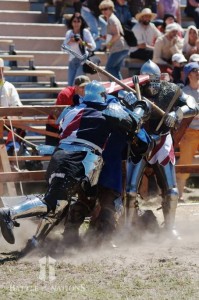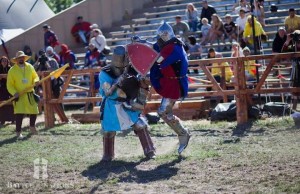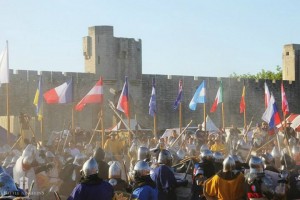
Today we have an article written by the organisers of a truly modern yet medieval sport … Historical Medieval Battle. One evening recently, Tim and I were channel surfing on our TV and stumbled upon a documentary about a team from the UK competing in an international medieval battling competition. We were both gripped that people were willing to get into full battle armour with real weapons and then terrified when they went into full-on combat with each other. Not just a re-enactment, real fights! It certainly kept the ambulances busy.
The 2014 event is being held in Croatia from the 12th to 15th June, and we wanted to know more, so we got in touch with the organisers and asked them to tell us more … over to Ekaterina Kabanova, manager of international development for HMBIA.
Historical Medieval Battle
Historical Medieval Battle (HMB) is a comparatively young sport. It goes back approximately twenty years and it is still developing its regulations basis and is still in the process of formation.
What is HMB?
Have you ever seen historical re-enactment battles? They often look hard, metal knights strike each other with steel weapons, hundreds of armoured fighters maneuver on the battlefield to defeat their opponents and show the beauty and supreme tactics of the medieval battle. Many of the battle reenactments are staged. They are prepared in advance and fighters know who will win, when to fall and when to courageously defeat the opponent. Sometimes even horses participate in these battle, you see bowers, catapults, trebuchets, cannons.
But often you can see the fighters move much faster, strike stronger and the results do not conform to the historical sources. That is a “buhurt”, a mass battle. But it isn’t real fighting.
Why is HMB special?

HMB is a full contact armoured fight with replicas of medieval arms (not sharp). And HMB is a real sport. Fighters train in the gyms, prepare for the championships and go to local tournaments, national events and international championships. In Russia, the motherland of HMB, it is already an official sport. But HMB is more than just a sport for many, it is also a cultural movement, a real lifestyle.
First of all HMB is a multi sport combination which challenges the sportsman to be strong in a great amount of disciplines. HMB makes the fighter become proficient with all kinds of weapons. HMB sportsman must kick and hit well, he must know how to wrestle, he must be a good fencer and moreover he must understand the tactics of a mass battle and generally be in very good physical condition. Fighting in metal armour which can weigh up to 30kg is not an easy thing.
Apart from being a unique sport in terms of competition, it is the only existing full contact sport which has a mass battle where many participants fight at once.
HMB is a very historically and culturally related kind of sport. All the equipment used by the sportsmen is not only designed for sport needs, it is a reconstruction of arms and armour used in the period by medieval warriors. So you don’t just see sportsmen on the battlefield, you see knights as they really looked in the Middle Ages.
And the third concept which is connected to HMB is the concept of “fight and travel”. The main idea is that with HMB you can find a very convenient way to meet new people and see new places, and at the same time improve your level as a sportsman and participate in competitions all over the world. All HMB clubs around the world are always happy to have guests from different countries and cities. Generally the concept appeared due to the fact that in one city there were usually not enough fighters for a big competition, so to every competition the fighter usually had to go to another city. And that way the concept of “fight and travel” appeared.
History of HMB
The first attempts of historical fencing, as it was called then, appeared in the ’90s in Russia and Ukraine. By 2005 the movement became popular with dozens of serious events organized during the year. But it faced the problem of different rules on different events and thus it was impossible for the fighters to define the best of the best. There was no possibility to organize a universal championship due to the difference in rules respected by different fighters. This problem had to be solved and thus it led to the understanding that unified international rules had to be developed.
HMB as a concept appeared before the first “Battle of the Nations”, which took place in Ukraine in 2010. As a result, this tournament became the world championship in HMB and turned into the most anticipated event of the year, an event which shows the vector of development of this sport. “Battle of the Nations” was the first tournament which proposed the fights in the format of national teams. To create the team every country participant had to organize several selection tournaments. After 4 participating countries at the first “Battle of the Nations” 2010, the championship grew to more than 20 participating countries in 2013. It was hosted by Poland in 2012 and France in 2013. It gave the most serious push to development in the history of HMB. Also HMB developed Unified International rules which regulate the fight, the equipment, the principles of judging and the requirements of the lists (the battlefield). It was a serious step towards the international approval of HMB as an official sport.
“Battle of the Nations” is organized by HMBIA – Historical Medieval Battle International Association. The first international association which represents the sport at international arena and runs serious PR campaigns to make it popular and get its official approval. HMBIA has representatives in all countries participating in “Battle of the Nations” and they promote the movement in their countries helping its development at all levels.
Sport categories
And to fully understand HMB let’s make a short analysis of its competitive categories. All categories in HMB are divided into “1 on 1” fights and mass battles. In “1 on 1” fights, the two fighters are competing against each other on the battlefield. It can be a tournament (sword-sword, sword-shield, sword-buckler etc.) where points are calculated and melee fighting and wrestling is forbidden. Or it can be a pro fight where apart from fencing the fighters can wrestle and use almost any techniques of melee fighting. By the way, HMB already has its first league of professional fights, WMFC (World Medieval Fighting Championship), which organizes pro fights all around the world.

And the second type of competitive category is mass battles. During these battles many fighters divided into two teams fight on one list. It can be “5 vs 5”, “21 vs 21” or “all vs all”, simply called a buhurt, where the number of participants is not limited. The main rule here is that you can continue to fight while you stand on your feet. If you fall – you are out of the fight and you cannot get up before the fight ends.
Fighters during the preparation use modern techniques and approaches similar to other martial arts: vast use of cross-training for stamina development, fight camps before serious events and even professional coaches who lead their apprentices to victory.
HMB already has its school of marshalls which get officially internationally accredited to be the judges at the HMB events.
That way HMB is constantly growing and developing. It has already become an internationally approved sport which gathers thousands of people all around the globe. It also started to develop a vast movement of fans who follow their favourite teams at the events. HMB is a sport with a modern approach, yet ancient, historical and cultural roots.
The 2014 event is being held in Croatia from the 12th to 15th June. You can find out more from the Battle of the Nations website here:
http://battleofthenations.ua/. You can watch battles at the HMBIA YouTube Channel – www.youtube.com/user/HMBIAChannel